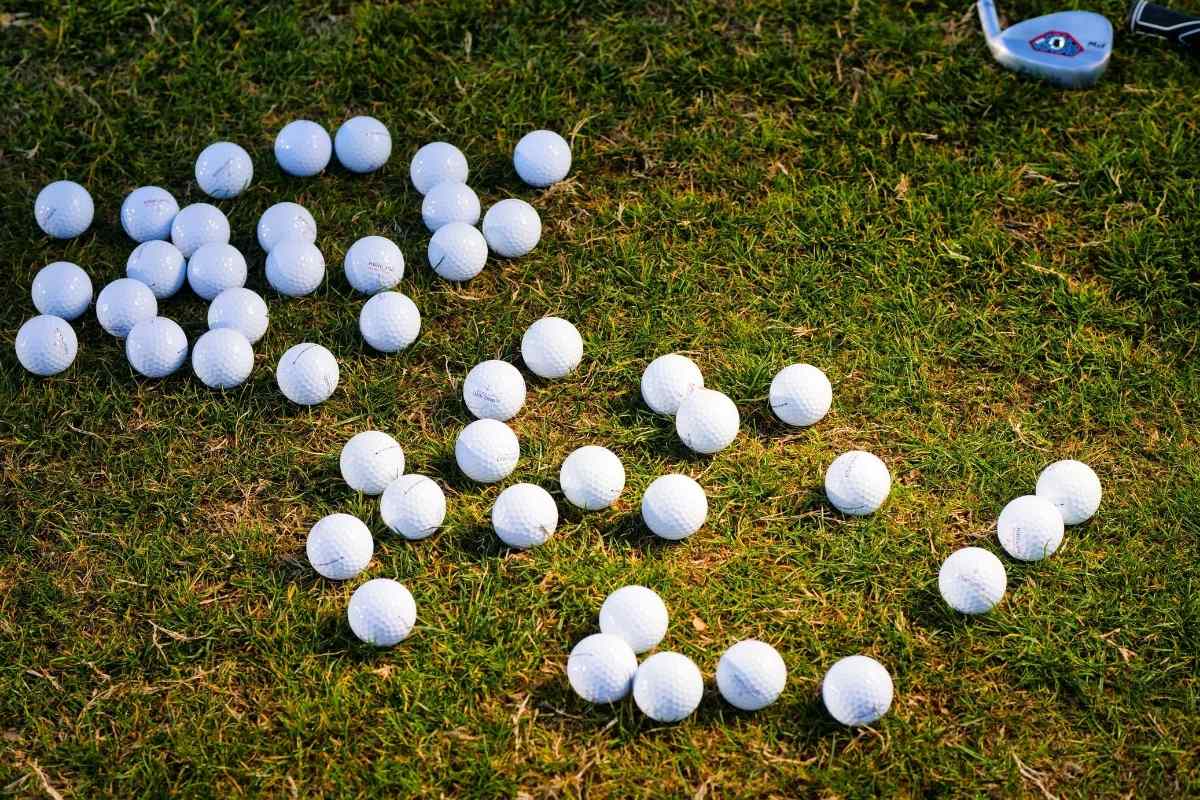You may think that feel is the only difference when considering soft vs. hard golf balls. However, that’s not the case; there’s more to it than that.
Of course, soft golf balls and hard golf balls feel considerably different. Many golfers can tell the difference as soon as they hit the ball.
But the construction of the balls and the materials used gives them that differing feel. And they also have contrasting features and characteristics because of that.
So, let’s take a look at the construction to identify the differences.
Soft vs. Hard Golf Balls: Construction
We can break down golf ball construction into the core, mantle, and cover. These three areas differ in soft vs. hard golf balls.
Core
The core is the center of the golf ball. You can think of it as the engine room of the ball, and everything revolves around it.
The core transfers the energy from the club to the ball and powers its flight. Without it, you might as well be hitting a ping-pong ball because the golf ball would go nowhere without the core.
The core is the most critical part of the ball and takes up the most space. You may have heard of golf balls having a compression rating.
That directly relates to the core. And there’s a big difference between the compression rating of soft and hard golf balls.
Soft Golf Ball Compression Rating
Soft golf balls have a softer core than hard golf balls. That gives soft golf balls a lower compression rating.
Balls have a compression rating ranging from around 30 to 120. So, 30 is the lowest, making a 30-compression ball the softest.
However, soft golf balls have a compression rating ranging from 30 to 70. Therefore, any ball with a compression rating below 70 is considered a soft golf ball.
Related: Low Compression Golf Balls (A Complete Guide)
Hard Golf Ball Compression Rating
Hard golf balls have a firmer core than their soft counterparts. So, hard golf balls have a higher compression rating.
Hard balls have a compression rating ranging from around 90 to 120. A ball with a 120-compression is the firmest ball out there.
Mantle
The mantle sits between the core and the cover. It has less impact on the soft vs. hard golf ball discussion.
The mantle relates more to characteristics such as spin and distance. Manufacturers fine-tune this part to make the ball travel further or spin more.
Although the mantle impacts the softness or firmness of the ball less than the core, it still has some effect. A distance ball will have a firm mantle, while a spinnier ball will have a softer one – distance balls are harder and spinnier balls softer.
Cover
The cover directly affects the feel of golf balls. For instance, a urethane cover feels softer, while an ionomer cover feels harder.
The materials also impact the characteristics of golf balls. You’ll get more spin with a soft urethane cover and less with a firm ionomer cover.
The softness of urethane covers makes them less durable than ionomer covers. However, you get better overall performance with urethane, which is why premium balls like Titleist Pro V1 and TaylorMade TP5 use this material.
Some golf balls also have Surlyn covers. These balls are some of the firmest on the market and are less popular than the others.
They offer golfers straight-up distance, though. That makes them more popular with beginners and high handicappers.
Who Should Play Soft and Hard Golf Balls?
Whether you play soft or hard golf balls depends on a few factors. Firstly, you should understand that there are trade-offs in different areas of the game with either choice.
A hard ball usually gives you more distance and less spin, and a softer ball generally offers more spin but less distance.
Please note that’s not the case with premium golf balls like the Pro V1. They give players the best of both worlds.
But let’s just say you don’t want to buy premium balls. In that case, it’s crucial to know the difference in performance between soft and hard golf balls.
Distance
OK, so hard golf balls offer you more distance. Therefore, you should use hard balls if more yards are critical to your game.
Sometimes beginners and high handicappers can shoot lower scores just by gaining distance. It leaves them closer to the green, giving them a better chance of hitting the putting surface with the approach shot.
However, there’s a trade-off in spin with that added distance. It’ll be harder to get the ball to stop quickly on shorter shots around the greens.
Related: 6 Best Golf Balls For Distance in 2022
Spin
Soft golf balls perform better when it comes to spin, but they generally give you less distance. So, you should use soft golf balls if spin will help your game more than the added distance.
Mid-handicappers can benefit from using softer golf balls. They might not need to gain much distance, but more spin on the greens can help them lower their scores.
The spin means they can stop the ball quickly on the greens. That improves their accuracy and gives them more birdie and par opportunities. Trading a little distance is a bargain for the chance to lower their scores.
Related: 5 Best Low Spin Golf Balls in 2022
Shot Shaping
It’s easier to shape shots (hit draws or fades) with soft golf balls because they spin more. Shot shaping with firm golf balls is much harder because they spin less.
Better players tend to put more value on shaping shots. So, golfers who know what they’re doing will get more from soft golf balls.
Shot shaping isn’t a big part of the game for beginners and high handicappers. They’ve other things to worry about (like hitting the ball), so hard balls are a better option.
Also, hard balls can travel straighter for these players because they spin less. They won’t slice or hook as much as soft golf balls.
So, mid-handicappers and lower should generally play soft golf balls. Beginners and high handicappers should play with hard golf balls.
However, we must consider another critical factor when identifying who should play soft vs. hard golf balls. We need to account for swing speed.
Swing Speed
Earlier, we covered how compression relates to soft and hard golf balls. Quick recap: soft golf balls have a low compression rating (30-70), and hard golf balls have a high compression rating (90-120).
Your swing speed directly relates to the compression rating you should use. It’s easier to transfer energy to a low-compression (soft) golf ball, while it’s more difficult to transfer energy to a high-compression (hard) golf ball.
Therefore, you should use soft golf balls if your swing is slow. Energy will transfer to the ball easier at impact, meaning you’ll get the optimal distance for your swing.
Related: 5 Best Golf Balls for Slow Swing Speeds in 2022
Players with fast swings should use high-compression golf balls. The firmer core helps deliver optimal energy transfer for the best results.
Related: 6 Best Golf Balls For High Swing Speeds in 2022
Golfers with slow swings won’t be able to compress the firm core in hard balls enough. So, they get a drop-off in performance, usually less distance.
Players with fast swings will compress a soft golf ball too much. That usually results in an overly high launch, negatively impacting their distance.
Therefore, using the wrong ball for your swing speed leads to suboptimal performance.
Pros and Cons of Soft Golf Balls
As you can see, soft golf balls have pros and cons. Let’s list them here for easy reference.
Pros
- More spin
- Better control
- Easier to compress
- Suit slow swing speeds
- Some players will get more distance
- Shot shaping
- Nicer feel
Cons
- Less durable
- Can spin too much (hooks and slices)
- May feel too soft for some
Pros and Cons of Hard Golf Balls
Hard golf balls also have their pros and cons. It’s that trade-off we identified earlier in the article.
Pros
- More distance
- Penetrating ball flight
- Harder to compress
- Suit fast swingers
- Straighter shots
- More durable
- Better for beginners and high handicappers
Cons
- Lack of spin around the greens
- Hard to shape shots
- Can feel harsh off the clubface
Conclusion
Now that we know the difference between soft and hard golf balls, we realize it’s not as simple as saying one is better than the other. Both types of balls have their pros and cons.
It depends on the golfer when it comes to soft vs. hard golf balls. You need to find the best golf ball for you.
There are always trade-offs unless you want to spend money on premium brands. For instance, soft golf balls offer more spin but less distance, while hard golf balls give you extra yards but less spin.
It’s best to think about your game and the areas you need to improve. You should go for a hard golf ball if you need more distance.
However, remember that swing speed plays a crucial part in your choice. Choosing a hard golf ball when you swing slowly results in less distance instead of more.
Swing speed does tend to complicate the choice somewhat. But follow the advice in this article to choose between soft and hard golf balls.
It’s a good idea to record your swing speed if you don’t know what it is. That information helps you in many ways, from improving your game to buying equipment.




